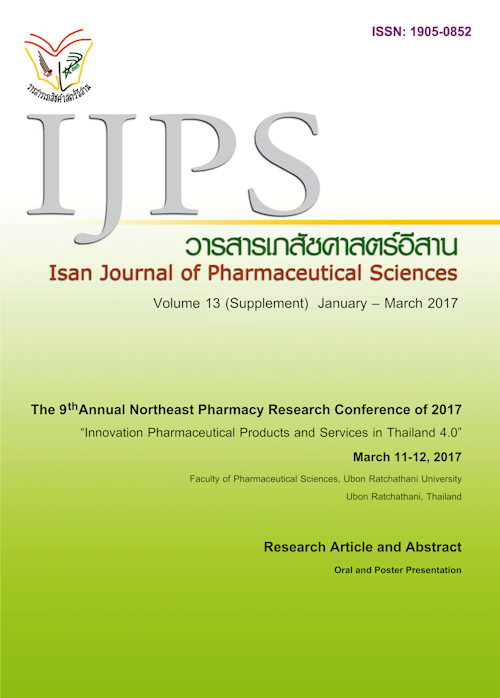Incidences of Adverse Drug Reactions due to Systemic Antibiotics from ADRs System at a Community Hospital
Main Article Content
Abstract
Introduction: Adverse drug reactions (ADRs) is one of the problem occurred during patient care and it can lead to a loss in patient health status and loss in cost for economics. The objectives of this study was to determine the incidence of adverse drug reactions for systemic antibiotics used in a community hospital from 1st January - 31st December, 2015. Methods: This retrospective study was conducted and data were obtained from patients` computerized database in the hospital. Patient collecting sheet was used to collect data while Naranjo`s algorithm was used to identify the causing ADRs. Descriptive statistics were used to analyze data. Results: There were 10,121 patients receiving systemic antibiotics and 57 developed ADRs. The incidence of ADRs was 563.19 per 100,000 patients. Of those 57 cases, ADRs were categorized by each class of antibiotics. The reactions most found in Cephalosporins 61.40% (35 cases), Penicillins 14.04% (8 cases), Fluoroquinolone 7.02% (4 cases), and Macrolides 7.02% (4 cases). Moreover, it was found that ADRs were commonly reported in skin 80.70% (46 cases) and cardiovascular system 7.02% (4 cases). In terms of severity, ADRs were reported as non-serious 80.07% (46 cases); increasing the duration of treatment 14.03% (8 cases), disability 3.51% (2 cases) and fatal 1.75% (1 case). ADRs were classified by causality assessment and it revealed that 15.79% (9 cases) was ipossiblej and 84.21% (48 cases) was iprobablej. Conclusion: Cephalosporins had the highest incidence of ADRs comparing to others. Therefore, pharmacovigilance and adverse reactions detection system is highly important to decrease any loss to the patients.
Article Details
In the case that some parts are used by others The author must Confirm that obtaining permission to use some of the original authors. And must attach evidence That the permission has been included
References
Dhar K. SA, Gaur P., Goel R., et al. Pattern of adverse drug reactions to antibiotics commonly prescribed in department of medicine and pediatrics in a tertiary care teaching hospital. J App PharmSci. 2015; 5(4): 78-82.
Ghamar TK, Fatemeh F, Zahra P, et al. Adverse reactions to antibiotics in hospitalized Iranian children. J Microbiol Immunol Infect. 2008; 41: 160-164.
Health Product Vigilance Center. SpontaneousReports of Adverse Drug Reaction2015. Health Product Vigilance Center (HPVC) [Internet]. 2015.[cited 2016 Sep 11]. Available from: http://thaihpvc.fda.moph.go.th/thaihvc/Public/News/uploads/hpvc_1_3_4_100538.pdf.
Khan FA, Huda N, Mishra H, et al. A prospective study on prevalence of adverse drug reactions due to antibiotics usage in otolaryngology department of a tertiary care hospital in North India. Int J Basic Clin Pharmacol. 2013; 2:548-53.
Kankaewla P and Permsuwan U. The direct cost of adverse drug reactions in patients. TJHP.2005; 15(1):30-39.
Renuka CV, Darling C. Retrospective analysis of adverse drug reactions induced by antibiotics in tertiary care centre. WJPR. 2014; 3(10): 1051-5.
Songsiripan R.Incidence and cost impact of adverse drug reactions in the medical ward patients at Hatyai Hospital.Songkla.Songkla University; 2002.


